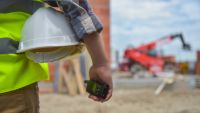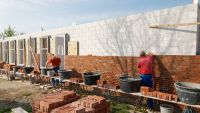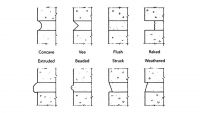Research Aims at Concrete Results for Coastal States
By Amber Miles
Thanks to a four-year, $3 million grant awarded to Louisiana Tech University's Trenchless Technology Center, researchers may soon be able to provide technical help to coastal states, especially after the destruction by Hurricanes Katrina and Rita.
The grant is the largest industry-funded research project ever for the university.
Dr. Henry E. Cardenas, an assistant professor of mechanical engineering at Louisiana Tech, along with 13 other researchers, is working on technologies that can support the recovery of safe habitation in the Gulf Coast disaster zones by conducting electrical treatments applied to concrete structures.
Cardenas said a large number of concrete and masonry block structures suffered damage and contamination from wind and water. This sets the stage for health problems related to indoor air quality and physical risks from hidden structural distress.
Some of these problems may not manifest for several years, Cardenas said. Chlorides from saltwater contamination can cause corrosion of steel reinforcement, which can destroy concrete over time.
"These treatments can be used to decontaminate, seal and strengthen concrete and masonry structures," Cardenas said. "Decontamination is done by using electricity to pull chemicals out of concrete that do not belong there. This type of work is going on right now at Kennedy Space Center with the hope of removing corrosive contaminants from shuttle launch platforms."
Cardenas said the concrete can also be sealed by using electricity to move tiny particles into pores. "These particles are referred to as nanoparticles because they can be as small as one 10,000,000th of an inch in size - too small to be seen by a regular microscope," he said. "These particles can also be driven several inches into the concrete, allowing us to radically increase the strength of the structure as well. If we pick them right, the particles will react with the fluids and surfaces inside the pores of the concrete. After the particles undergo these chemical transformations, the porosity of the concrete can be reduced, making the concrete less permeable and stronger."
After researchers conducted a four-day treatment on a masonry block, Cardenas reported a drop in permeability (a measure of how easily water can pass through the material) by a factor of 10, and an increase in strength of the block by as much as 130 percent. He hopes the recent advances in electrokinetic processing will eventually help, especially in areas affected by the recent hurricanes.
"They're doing things like rebuilding Interstate 10 now, but hopefully this is something to be used in the long run. You're probably talking about a year from now before any of this kicks into common use," he said.
Dr. Les Guice, vice president for research and development, said it is an exciting and important project for the university for a number of reasons. "The project demonstrates how technologies developed through advanced scientific research can be transferred into the marketplace," he said. "It is an innovative application of nanotechnology that has demonstrated commercial potential.
"We hope that this project is successful in leading to new business activity, which can have a significant impact on economic development in this region," Guice continued. "This project is particularly important for Louisiana and is coming at a time when we hope to see this technology provide some benefit to the rehabilitation of structures in the state."
Guice commended Cardenas' hard work. "Dr. Cardenas has done an excellent job in building relationships with industry collaborators," he said. "He has also found significant federal government interests in his work, including the Corps of Engineers and NASA, which demonstrates the far-reaching potential of his research."
Bobby Rawle, director of economic development, said he sees that potential. "Since this research is focused on solving real-world issues with concrete, and particularly with improving the properties of existing concrete, it may be a tremendous asset in re-mediating damaged concrete structures," he said. "This would obviously be important in disaster zones like those caused by Katrina, but ultimately may revolutionize how we approach aging structures all over the world."
Rawle said he is confident in the grant and the research efforts: "The size of this grant will allow this research to be extremely focused and greatly improve its real-world applicability. There is no doubt in my mind that this grant will be successful."
About the Author
Amber Miles is a staff writer for the Louisiana Tech University News Bureau.
Copyright © 2005, Louisiana Tech University News Bureau. Reprinted with permission.


















